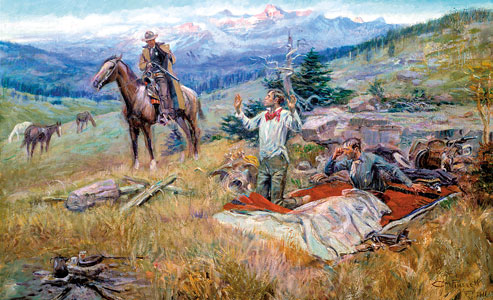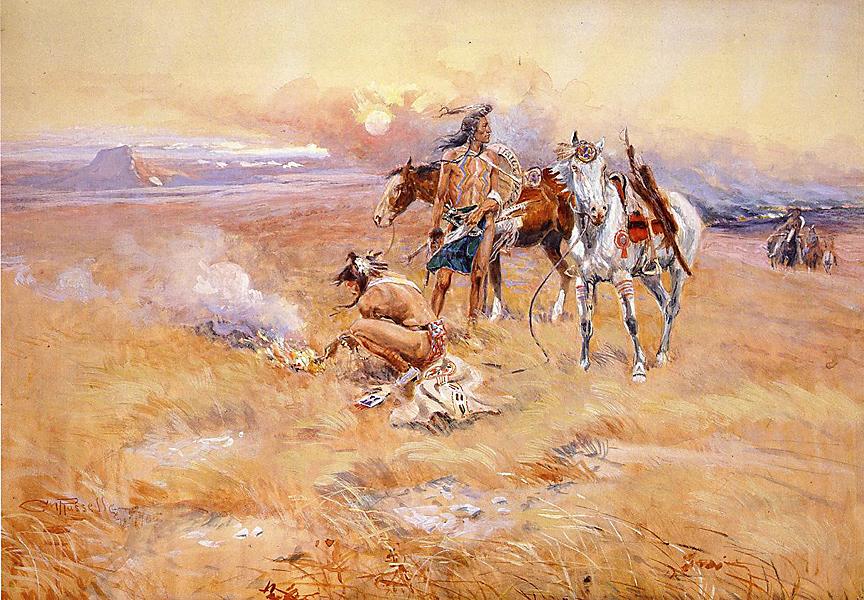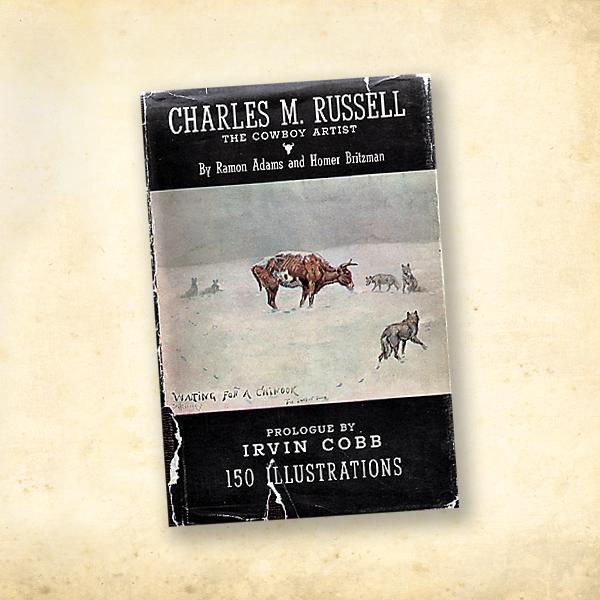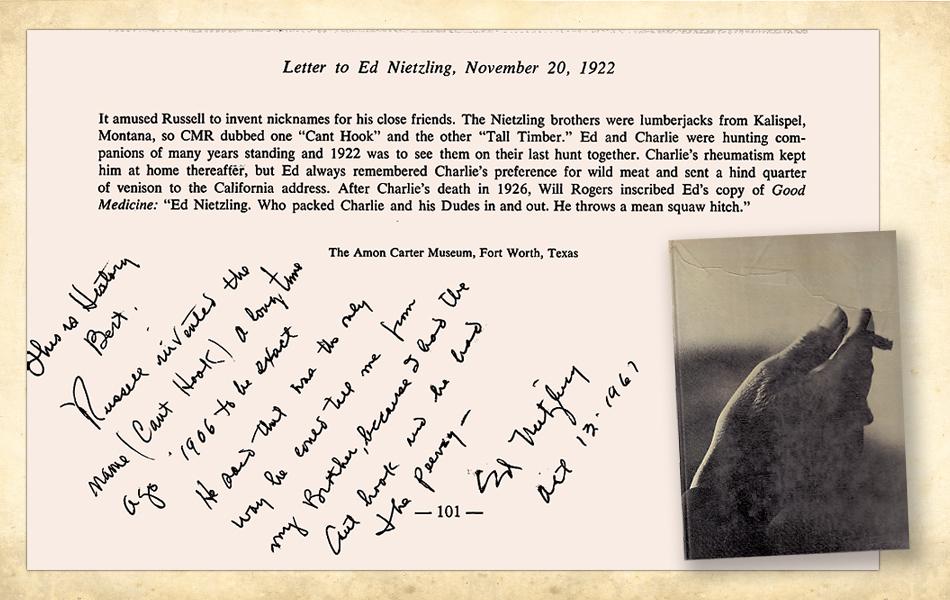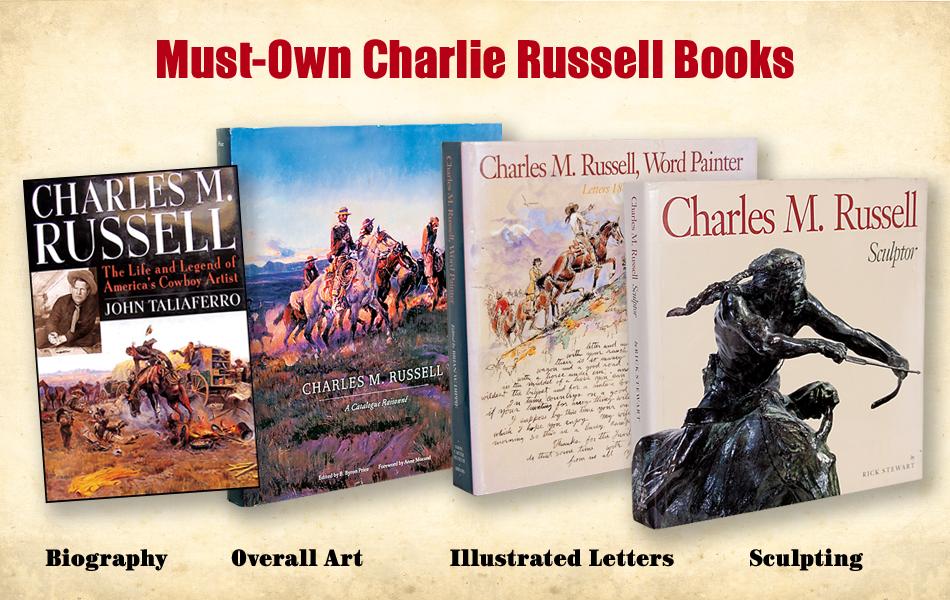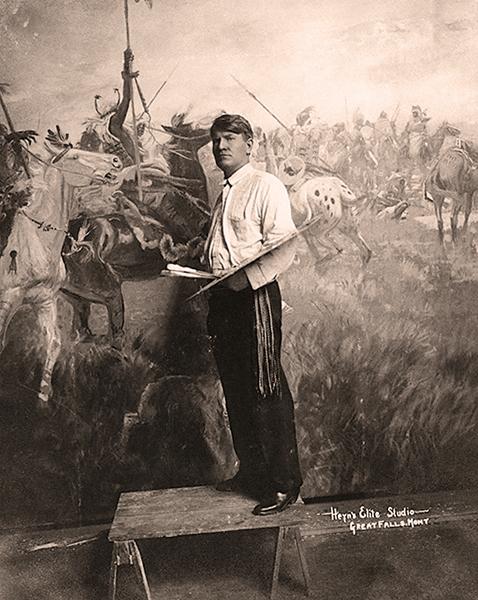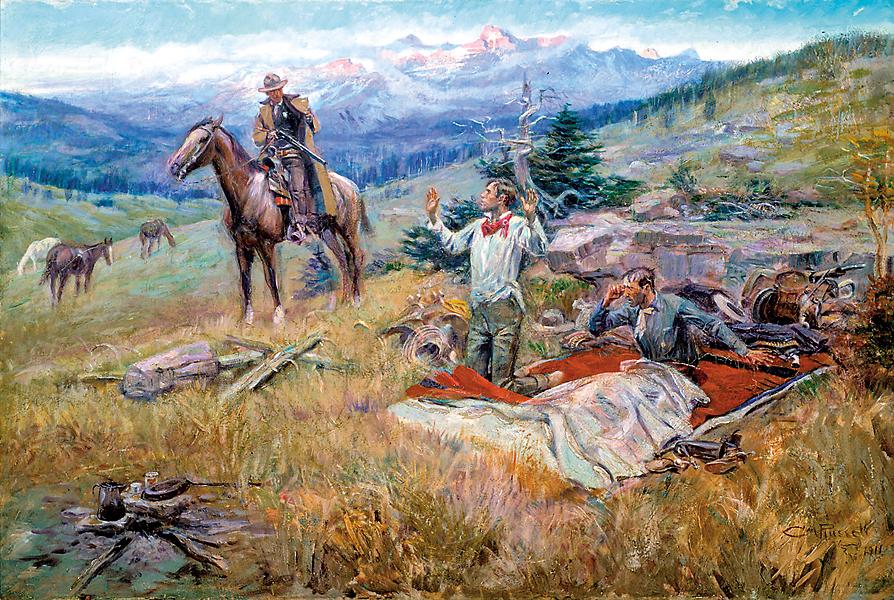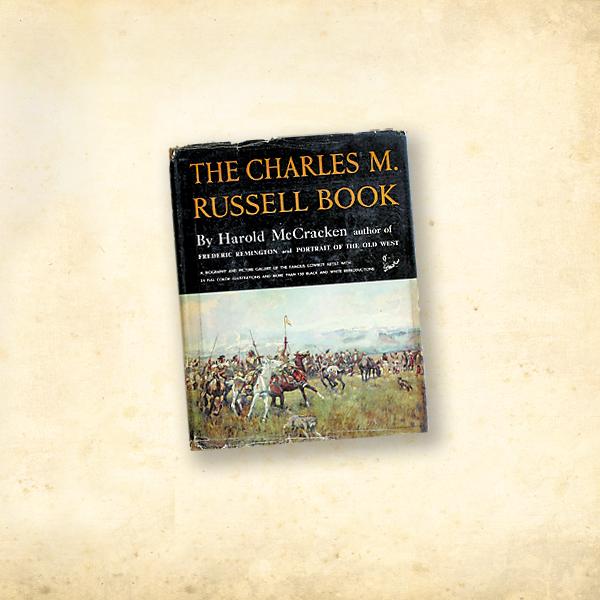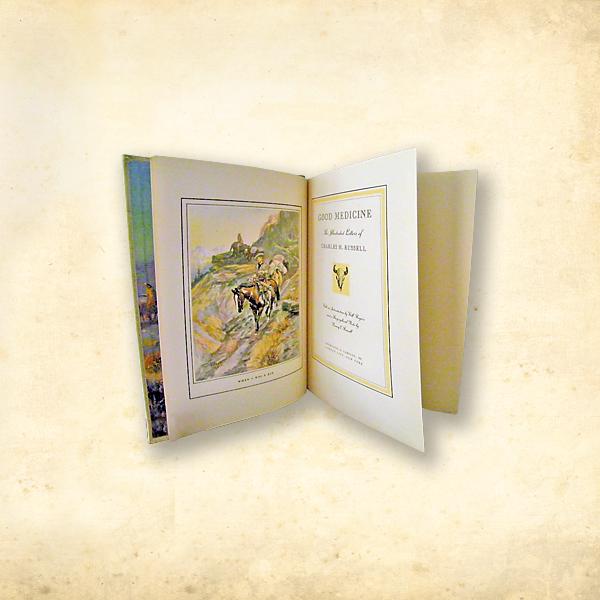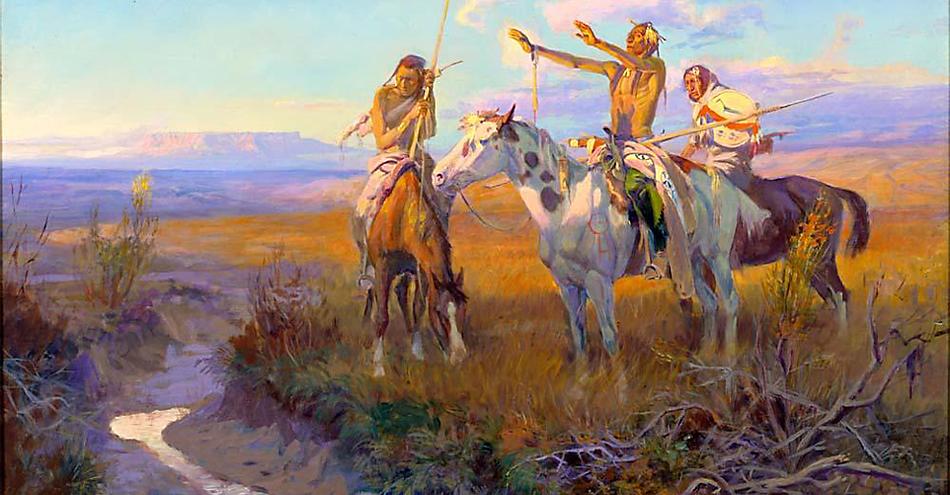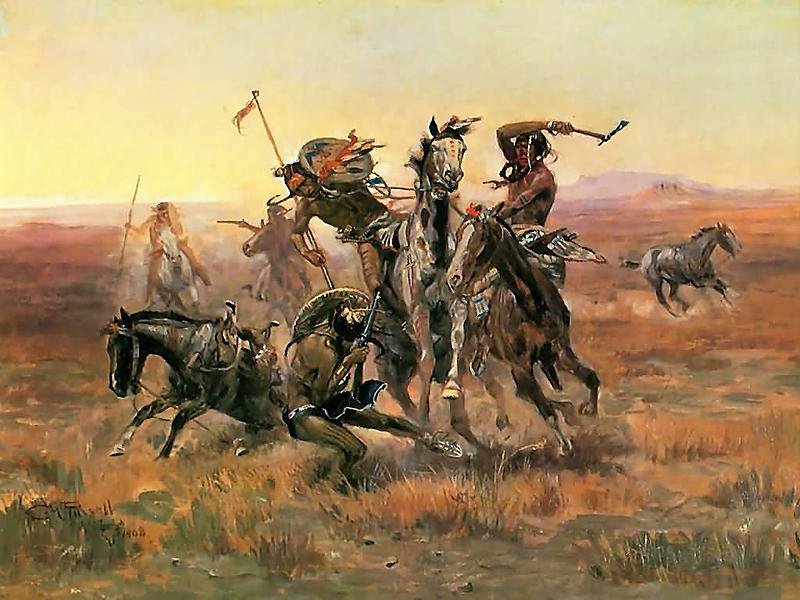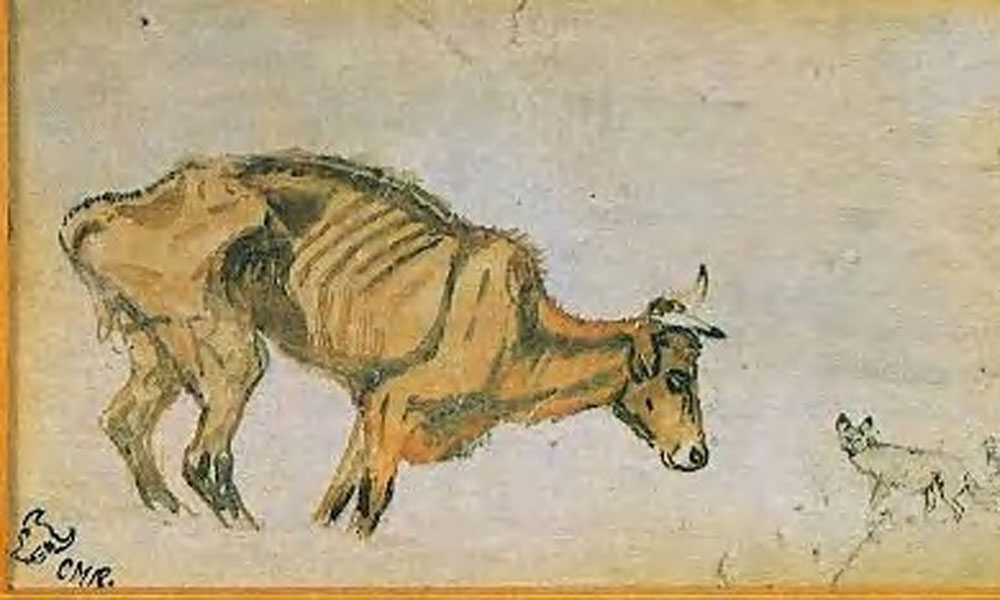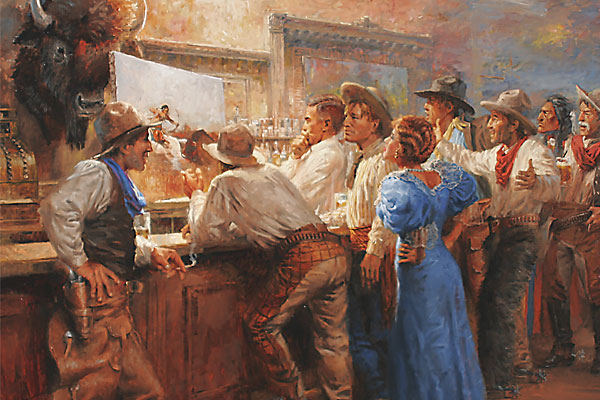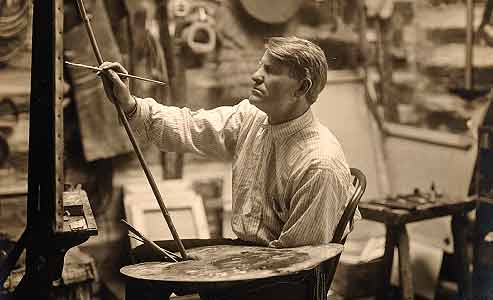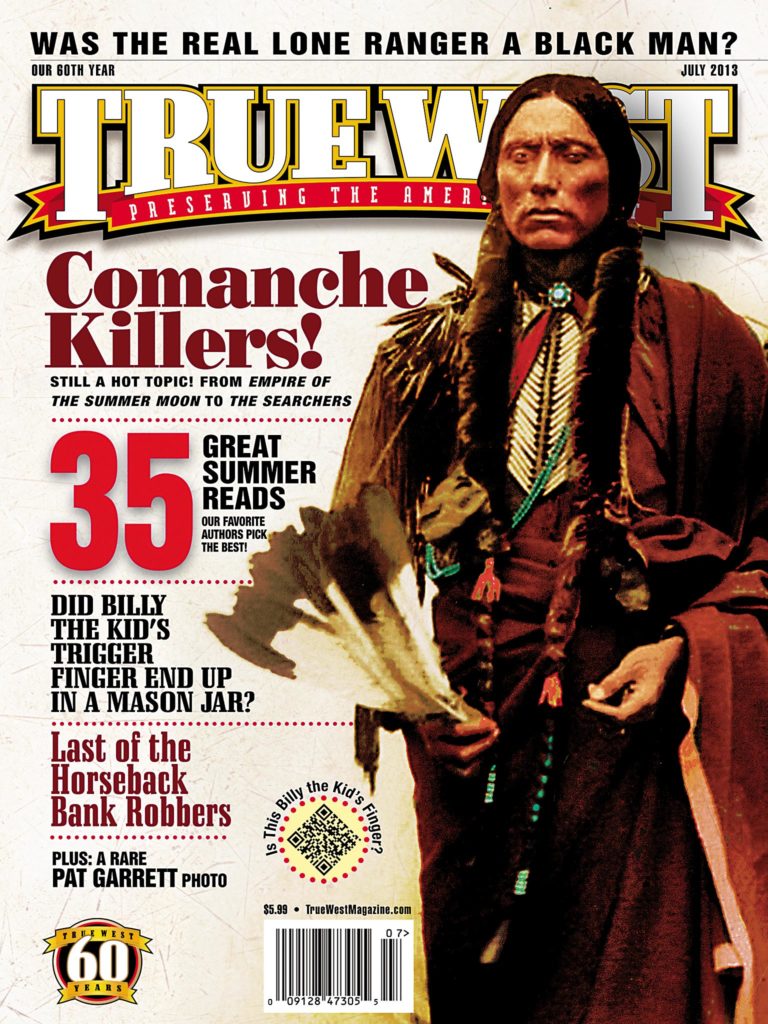
When I entered graduate school at Colorado A&M College in the fall of 1954, my roommate hung a Charles M. Russell print on his wall: 1911’s Call of the Law.
As I’ve learned, Russell liked to leave the outcome of a scene to the viewer’s imagination, and this one was no different—what did those two guys do and what was the aftermath?
The stories Russell’s art awakened in my mind encouraged me to purchase two inexpensive framed Russell prints to hang on my wall the next school year: 1908’s When Blackfeet and Sioux Meet and 1910’s The Sun Worshippers. These were soon followed by 1901’s Planning the Attack, 1905’s Blackfeet Burning Crow Buffalo Range and my all-time favorite Russell painting, 1912’s Lewis and Clark Meeting Indians at Ross’ Hole.
That beginning confirmed I would become deeply rooted in all things Western. These five prints have hung in either my office or home, from Colorado to Montana to Saskatchewan to Washington State and back to Colorado, where they now hang in my downstairs den.
I didn’t realize at the time what this simple collection had set in motion, but it didn’t take long to kick-start when the Montana Fish & Game Department hired me as a fisheries biologist in the summer of 1956, moving me to Kalispell, Montana, deep in Russell Country.
The Search Begins
My interest in Russell picked up during my second winter in Kalispell when my folks gave me a copy of Harold McCracken’s The Charles M. Russell Book for Christmas. Little did I know that this would be the first piece of my printed collection. I realized soon after that although I could not afford to purchase original Russell paintings, I could afford to collect literature written about and by him.
In Kalispell, I was fortunate to meet and forge a lasting friendship with Bob Neitzling and his family. Bob’s dad, Ed, was one of the packers who guided Russell on his periodic hunting trips into the South Fork of the Flathead River. Ed was a gold mine for me. Both Neitzling families welcomed me into their homes and lodge on Lake McDonald.
Ed called my attention to Russell’s published stories in Trails Plowed Under, a must-have book for anyone interested in Russell, and I added it to my nascent collection. (Ed’s leather-bound presentation copy of this book, which had been signed by Will Rogers and Nancy Russell, was unfortunately stolen after he loaned it for a Russell exhibition.)
To guide my Russell literary collection, I decided to collect only those publications that contained significant information about the cowboy artist’s art, life or related event. I would stay away from publications that featured only Russell illustrations, but no significant information, as well as newspaper articles.
Settling in for the Long Run
After a three-year detour to work on my doctorate at the University of Saskatchewan, I moved with my wife to Richland, Washington, in 1961. I attended work-related scientific conferences throughout the country, and one of my first actions after settling into my hotel room was to call used and rare bookstores to find out what the owners had in the way of publications by or about Russell and in back issues of Montana, the Magazine of Western History or American Indian Art Magazine. The Internet largely supplanted my bookstore visits after I retired in 1995 and work-related travel ceased, though I still visit bookstores when I can.
I learned the value of patience during this time. A book dealer had been trying to sell me a 1968 edition of Mary Joan Boyer’s The Old Gravois Coal Diggings, which contained early history of the Russell family in St. Louis. He wanted $150, but I thought that too high to pay for what little information it contained on Russell. Last year, I found an autographed first edition, published in 1952, of the book for $50.
Soon after moving to Richland, I added Rawhide Rawlins Stories and More Rawhides to my collection so that I had all three books Russell had written. I’ve read them all several times.
In the 1970s, Ed and Ella Neitzling visited us in Richland. Ed saw my copies of Good Medicine and Paper Talk that contained reproductions of Russell’s letters. Three of them were “thank you” letters sent to Ed. He asked for a pen and wrote short notes in the margins of the reproductions explaining their history. The original letters are presently at the Petrie Institute in Denver, Colorado.
During this period, I had the good fortune to write to Dr. Brian Dippie, the noted Russell authority from the University of Victoria in British Columbia, to tell him about the annotated Neitzling letters. At the time, Dippie was working on his seminal book on Russell letters, Charles M. Russell, Word Painter. Over the years, we have become good friends and Dippie has, whether he knows it or not, become my de facto mentor on all things Russell. His numerous books and essays on Russell and his art are the most insightful, eclectic and thorough of any writer. He has been most generous with his time and has led me to many lesser-known publications. Without him sending me copies, I’m not sure when or if I would have learned of his publications From Frog Lake to Saskatoon: Charlie Russell’s Canadian Connection or Remington and Russell Revisited. He’s always made this “wannabe” feel like a more knowledgeable collector than I really am.
Two other books I obtained during this period include Charles M. Russell: The Cowboy Artist by Ramon Adams and Homer Britzman and C.M.R.: Charles M. Russell, Cowboy Artist, authored by Austin Russell, the artist’s nephew. The latter is important for the familial information.
I also obtained what I consider the gem of my collection. Dick Upton, a California book dealer, phoned me to say he had located a first edition copy of George Bird Grinnell’s When Buffalo Ran, published in 1920. It contained an inscription from Grinnell to Russell and a copy of a Russell library bookplate. (I’ve since learned that Britzman and a book dealer friend added the bookplates after Britzman had bought the bulk of the Russell estate.) Upton’s phone call came on my birthday; I said “Happy Birthday” to myself and bought it. The inscription reads: “Chas. M. Russell: A reminder of the good old days. Geo Bird Grinnell, January 1921.” Not a Russell original, but it was owned by the artist!
I continued to rapidly accumulate books, both softbound and hardbound, periodicals, catalogs and other ephemera. In the 1990s, I was fortunate to obtain Kid Russell, a collection of Russell’s boyhood sketches published in 1989; only 22 signed and numbered copies exist of this book.
Many, many excellent books containing reproductions of Russell’s art and information about his life have been published, and I would be foolhardy to say one is better than the other. With that said, here are my choices for the definitive books. For overall art, I would select 2007’s Charles M. Russell: A Catalogue Raisonné, edited by B. Byron Price. The seminal book on Russell’s unique illustrated letters would be 1993’s Charles M. Russell, Word Painter, edited by Brian W. Dippie. Rick Stewart’s 1994 book Charles M. Russell, Sculptor thoroughly reviews Russell’s major sculpting efforts. Finally, for overall biography, I would choose 1996’s Charles M. Russell: The Life and Legend of America’s Cowboy Artist, written by John Taliaferro.
The Trips
My publication collecting has continued into retirement, but perhaps my most memorable Russell experiences during the last dozen years are trips I have taken to view major Russell museum collections and historical sites.
The first of these was in the summer of 2000. My brother and his wife joined us on a drive from our Colorado homes through Montana. Our first destination was the Jake Hoover cabin near Utica where Russell had spent part of his youth learning from the trapper and hunter. We then drove to Great Falls to visit the Charles M. Russell Museum, Russell’s log cabin studio, the Russell home and Russell’s grave.
Our next stop, in Helena, to visit the Montana Historical Society’s museum and its Mackay Collection, was to culminate with my ultimate goal, a viewing of the masterpiece mural Lewis and Clark Meeting Indians at Ross’ Hole at the capitol. I had seen this painting briefly many years before, but I wanted a better look at it, now that I knew more about its history—the fee Russell had been paid ($5,000), the problems he had while working on it in his studio, even the fact that a part of the original canvas had to be trimmed to fit it into its present location.
The visit to the museum and Mackay Collection was excellent, but disaster loomed. At the capitol, a guard told us that parts of the building were undergoing renovations and that the House of Representatives’ chambers, where the painting is located, was closed to visitors. I was crushed. I pleaded for a peek, but he was adamant. I even tried sneaking past the barricades, but to no avail. To this day, I’ve only had the one brief look. I’d still like to get back to see it in person.
The second extensive trip we took was to visit major Russell collections in Oklahoma and Texas in 2005. The first stop was the Woolaroc Museum near Bartlesville, Oklahoma. The overall art and Indian art in the collection exceeded my expectations, though I had hoped to see more Russell pieces on exhibit. The next morning, we visited the Gilcrease Museum in Tulsa, which houses a Russell collection that shouldn’t be missed by any Russell aficionado. We then traveled to the National Cowboy & Western Heritage Museum in Oklahoma City. Here, besides admiring the Russells, I was able to view another one of my favorite paintings, Howard Terpning’s 1981 oil, Moving Day on the Flathead, a scene of one of my favorite Montana locales. The extent and variety of this museum is amazing.
From Oklahoma, we headed to Fort Worth, Texas, to visit the Sid Richardson Museum and the Amon Carter Museum. I had already acquired the major Russell publications from these institutions, but I added some newer brochures and catalogs on their impressive Russell art.
In past trips, I have also viewed the Russells at the Buffalo Bill Historical Center in Cody, Wyoming, the Brinton Museum in Sheridan, the Maryhill Museum of Art in Goldendale, Washington, the Glenbow Museum in Calgary, Alberta, and the Denver Art Museum in Denver, Colorado. Perhaps the greatest Russell collection I ever saw at a single site was “The Masterworks of Charles M. Russell” exhibition that we viewed at the Denver Art Museum in 2010. Absolutely fantastic; I was amazed that so many masterpiece paintings could be put together for a single exhibition.
Next on my wish list is to view the Russell collections at the Eiteljorg in Indianapolis, Indiana, and the Rockwell in Corning, New York.
The End of the Search
My 59-year search for Russell-related publications has resulted in my making many friends and having some remarkable experiences. As I recently said to Dippie, the fun is in the search and chase, but the chase is about over. Presently, my collection consists of more than 250 items ranging from rare signed first edition books to ephemera, with a few bound collections of prints. I’m contemplating selling or donating the collection, but I’m sure I’ll keep a couple of my favorite books around to keep me company. As the old saying goes, “Breaking up is hard to do.”
Colbert E. Cushing lives in Estes Park, Colorado. The retired stream ecologist has been collecting literature by and about artist Charles M. Russell for nearly 60 years.
Photo Gallery
Russell’s Blackfeet Burning Crow Buffalo Range is now owned by the Buffalo Bill Historical Center in Cody, Wyoming.
Russell’s Planning the Attack [No. 2] is in a private collection.
– Courtesy Gilcrease Museum Britzman-Russell Collection –
The Sun Worshippers is also in a private collection.
When Blackfeet and Sioux Meet is owned by the Sid Richardson Museum in Fort Worth, Texas.

